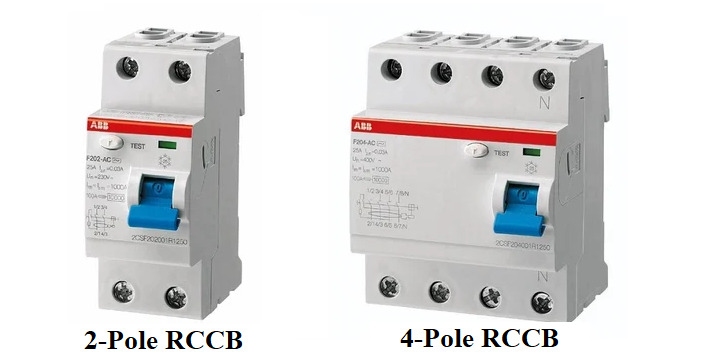
 Data Structure
Data Structure Networking
Networking RDBMS
RDBMS Operating System
Operating System Java
Java MS Excel
MS Excel iOS
iOS HTML
HTML CSS
CSS Android
Android Python
Python C Programming
C Programming C++
C++ C#
C# MongoDB
MongoDB MySQL
MySQL Javascript
Javascript PHP
PHP
- Selected Reading
- UPSC IAS Exams Notes
- Developer's Best Practices
- Questions and Answers
- Effective Resume Writing
- HR Interview Questions
- Computer Glossary
- Who is Who
Residual Current Circuit Breaker (RCCB) - How It Works
Residual Current Circuit Breaker (RCCB) is a type of circuit breaker used in electrical circuits for protection purposes. The primary function of an RCCB is to detect a leakage in the circuit current. If there is any leakage in the current, the RCCB can interrupt the circuit and prevent the fault to be happened.

Read this article to understand the functions, working principle, advantages, and applications of RCCB.
What is an RCCB?
RCCB (Residual Current Circuit Breaker) is a protecting device that detects any leakage current in the circuit and interrupt the circuit current. When a fault occurs in a circuit, there is a change in the circuit current. The RCCB is provided in the circuits to detect this change in the current.
Basically, the primary purpose of installing an RCCB in a circuit is to protect the living beings from electric shocks and avoid electrical accidents. An RCCB can disconnect the main electric circuit within a fraction of second when a fault occurs in it. Therefore, RCCB is one of the important safety and protection devices.
RCCBs are useful in detecting and protecting circuits from sudden earth faults, as they are highly capable in immediate tripping of the circuit and thus protecting the persons from an electric shock.
Working Principle of RCCB
The working of an RCCB (Residual Current Circuit Breaker) is based on the Kirchhoff's Current Law (KCL) which states that the incoming and outgoing currents in an electric circuit must be equal. The RCCB utilizes this law to compare the difference between phase and neutral currents in an electric circuit.
In any electrical circuit, the phase wire is the conductor that carries electric current from source to load and the neutral wire is the conductor that carries the electric current from load to source. Ideally, these two currents must be equal. This happens only when there is no leakage of current in the circuit.
In case of a fault, the current in the neutral wire becomes unequal to the current in the phase wire. The difference between these two currents is known as residual current. When the RCCB detects the residual current in the circuit, it trips off the circuit.
This is how an RCCB (Residual Current Circuit Breaker) operates and disconnect the circuit in case of a fault.
Types of RCCBs
Depending on the number of poles, RCCBs are classified into two types namely,
2-Pole RCCB It is also known as single-phase RCCB. A 2-pole RCCB contains only two wires namely, a phase wire and a neutral wire.
4-Pole RCCB It is also known as three-phase RCCB and is used in three-phase electrical systems. A 4-pole RCCB contains three phase wires and one neutral wire.

Advantages of RCCB
The main advantages of RCCB are listed as follows
RCCB can provide protection against sudden earth fault and any other kind of leakage current fault.
RCCBs are easy to install and operate.
RCCB has automatic circuit disconnection feature.
RCCB has simple test and reset buttons.
RCCB also protect circuits from voltage fluctuations.
Disadvantages of RCCB
Some of the major disadvantages of RCCBs are listed below
RCCBs are mainly designed to work with standard waveforms. If no standard waveforms are present, then RCCBs will not operate properly.
RCCBs can operate unintentionally if any sudden change in the electrical load occurs.
An RCCB cannot protect against overload conditions.
RCCBs are not capable in protecting against overheating due to improper joints or screwed conductors.
RCCBs cannot protect against line-neutral shocks.
Applications of RCCB
RCCB (Residual Current Circuit Breaker) is an important protection device used in electrical circuits to protect human from getting electric shocks. RCCB are used in both single-phase and three-phase systems to detect any leakage current in the circuit and interrupt the flow of current if there is any fault.
Conclusion
Residual Current Circuit Breaker (RCCB) is a protecting device used to minimize the risk of electric shocks and electrical accidents that might cause death. Therefore, RCCBs are an important component, especially in high-voltage systems.

